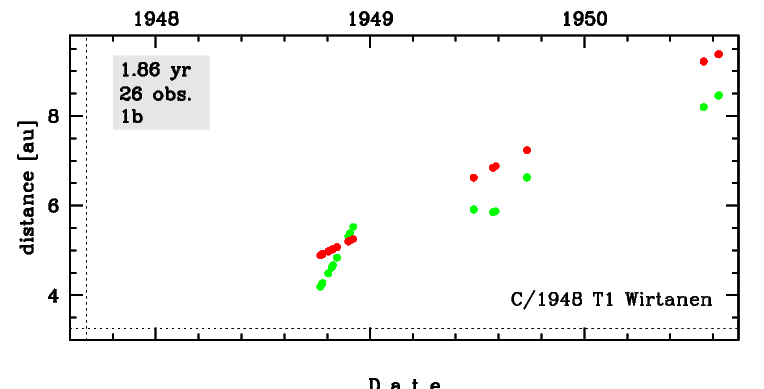C/1948 T1 Wirtanen
more info
Comet C/1948 T1 was discovered on 7 October 1948, about 13 months after perihelion passage and was last seen on 11 September 1950 [Kronk, Cometography: Volume 4].
This comet made its closest approach to the Earth on 26 October 1947 (2.44 au), that is one month after perihelion passage and almost one year before its discovery.
Solution given here is based on data spanning over 1.86 yr on postperihelion leg of orbit in a range of heliocentric distances from 4.89 au to 9.38 au.
This Oort spike comet suffered small planetary perturbations during its passage through the planetary zone that caused a bit tighter future orbit (see original and future barycentric orbits).
More details in Królikowska et al. 2014 andKrólikowska and Dybczyński 2017.
This comet made its closest approach to the Earth on 26 October 1947 (2.44 au), that is one month after perihelion passage and almost one year before its discovery.
Solution given here is based on data spanning over 1.86 yr on postperihelion leg of orbit in a range of heliocentric distances from 4.89 au to 9.38 au.
This Oort spike comet suffered small planetary perturbations during its passage through the planetary zone that caused a bit tighter future orbit (see original and future barycentric orbits).
More details in Królikowska et al. 2014 andKrólikowska and Dybczyński 2017.
| solution description | ||
|---|---|---|
| number of observations | 26 | |
| data interval | 1948 10 07 – 1950 08 17 | |
| data type | observed only after perihelion (POST) | |
| data arc selection | entire data set (STD) | |
| range of heliocentric distances | 4.89 au – 9.38au | |
| detectability of NG effects in the comet's motion | NG effects not determinable | |
| type of model of motion | GR - gravitational orbit | |
| data weighting | NO | |
| number of residuals | 52 | |
| RMS [arcseconds] | 0.94 | |
| orbit quality class | 1b | |
| orbital elements (heliocentric ecliptic J2000) | ||
|---|---|---|
| Epoch | 1947 09 12 | |
| perihelion date | 1947 09 04.42951500 | ± 0.01032300 |
| perihelion distance [au] | 3.26110877 | ± 0.00011350 |
| eccentricity | 1.00227683 | ± 0.00003289 |
| argument of perihelion [°] | 73.464822 | ± 0.001866 |
| ascending node [°] | 122.120668 | ± 0.000217 |
| inclination [°] | 155.077948 | ± 0.000265 |
| reciprocal semi-major axis [10-6 au-1] | -698.18 | ± 10.07 |
